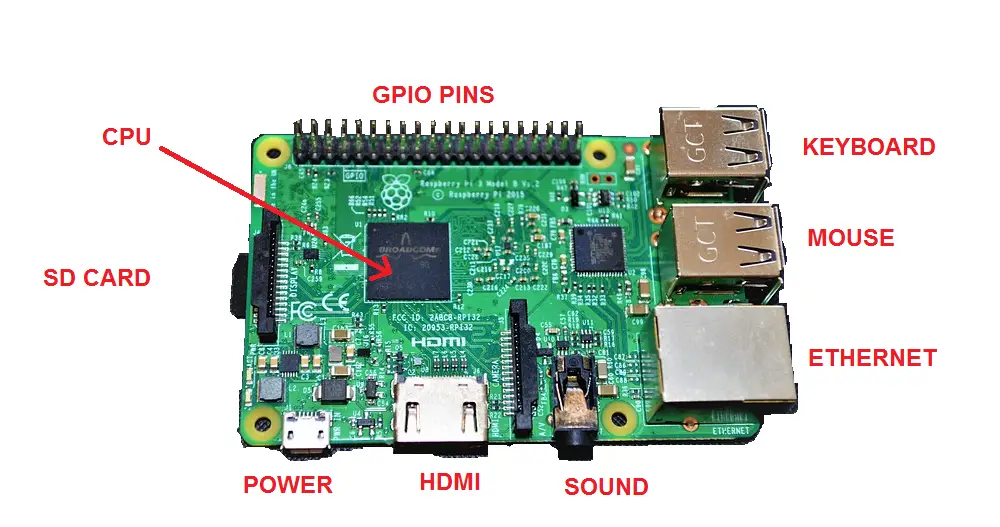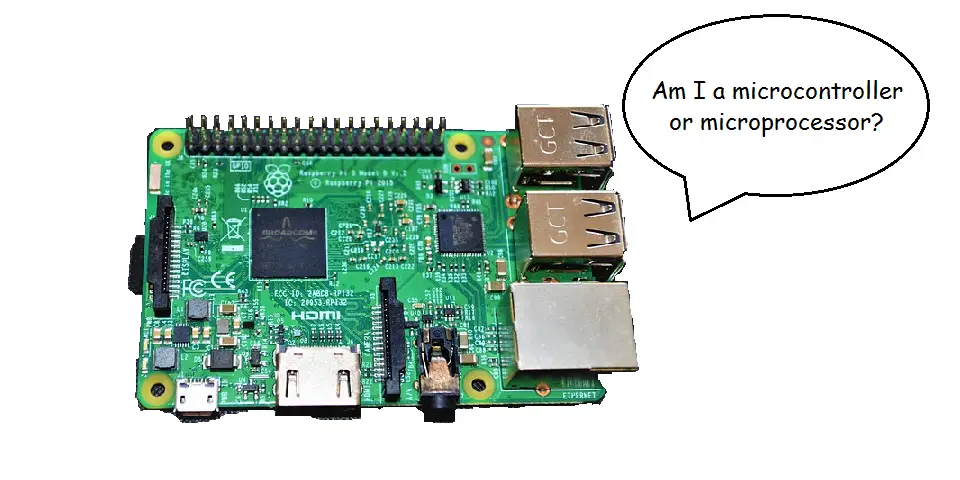The Raspberry Pi has made a massive mark in the electronic world. It is essentially a tiny computer that can fit in the palm of your hand.
You can connect outputs like monitors or televisions, as well as connect inputs like a keyboard and mouse just like you would a normal computer.
The great added benefit of the raspberry pi is that it can be programmed according to your needs for a certain purpose or project. It is programmed using coding languages like Scratch and Python.
You might be on the lookout for a new raspberry pi, or already have one lying around and are wondering if it is a microcontroller.
So is a raspberry pi a microcontroller? The raspberry pi is not a microcontroller. It is a single-board (the size of a credit card) that emulates a computer. However, just like a computer, it requires a processor as its brains to operate. It uses a microprocessor (not a microcontroller) as the main processor.
This article shall take a deeper look as to why a raspberry pi is not a microcontroller.
What is a raspberry pi? – A closer look
To better understand why a raspberry pi is not a microcontroller, it will help to take a closer look at the raspberry pi individually.
The first raspberry pi was launched in 2012, created by the Raspberry Pi Foundation, which is a UK charity whose main focus is to make it easier and more accessible for people to learn about computing.
So, what exactly is it?
The raspberry pi has all the makings of a small computer which can fit in the palm of your hand. It uses Linux as its operating system.
It is very similar to a development board as it includes a set of General Purpose Input-Output (GPIO) pins allowing you to connect a range of inputs and outputs for prototyping personal projects such as home automation.

Different parts of a raspberry pi
Just like a computer, the raspberry pi is an embedded system comprising different hardware sections that each have its own functionality contributing to the overall system. Below are the hardware components;
- Central Processing Unit (CPU)
- Memory (RAM)
- Graphics Processing Unit (GPU)
- Ethernet port
- GPIO pins
- Xbee socket
- Power source connector
- Universal Asynchronous Receiver-Transmitter (UART)
- HDMI
Central processing unit (CPU)
The first and most crucial hardware component of a raspberry pi is the Central Processing Unit (CPU).
The CPU is the brain of the entire system which has the job of undertaking all operations (logical and mathematical) that occur within the raspberry pi.
It is very similar to how our brain handles all operations and tasks within the system of the human body.
The raspberry pi uses an ARM11 series microprocessor as the CPU (we shall take a more in-depth look at this when we discuss why a raspberry pi is not a microcontroller).
Memory (RAM)
Random Access Memory (RAM), is where a computer stores its short term memory. It uses it for all active programs and apps.
It is used for the same purposes in a raspberry pi for things like compiling large pieces of software, running server workloads, and running applications.
Graphics processing unit (GPU)
The Graphics Processing Unit is a chip within the raspberry pi that is responsible for accelerating the process of graphics rendering. It is capable of processing many pieces of information simultaneously.
Ethernet port
The great ability of the raspberry pi is to be able to access the internet. It does this through its Ethernet port which connects to a router.
GPIO pins
The General Purpose Input Output (GPIO) pins are used to interface digital and analog inputs and outputs to the raspberry pi such as buttons, sensors, motors, LEDs, etc. This allows you to give the raspberry pi added abilities.
XBEE socket
Wireless communication is very prominent in the electronic scene. The Xbee socket is used to give the raspberry pi the means of wireless communication.
UART
The Universal Asynchronous Receiver Transmitter (UART) is another form of communication that the raspberry pi utilises. It is an input/output port used to transfer data serially (one at a time) in the form of text.
HDMI
Last but not least, is the HDMI port.
HDMI or High Definition Multimedia Interface is an audio/video interface used for transmitting uncompressed video and audio data. The raspberry pi has an HDMI port to be able to interface with other HDMI compatible devices such as monitors and televisions.
Why the raspberry pi is not a microcontroller
Now that we have taken a closer look at the raspberry pi, we can answer the question if it is a microcontroller or not.
So, is a raspberry pi a microcontroller?
No, the raspberry pi is not a microcontroller. As we just saw, it is essentially a miniature embedded computing system the size of a credit card, which comprises different parts such as the CPU, GPU, GPIO pins, etc. It is a development board similar to an Arduino (however, a raspberry pi has greater computing power).
A microcontroller on the other hand is also very similar to a computer, which is embedded on a single integrated chip. It is used as the brain of embedded systems to handle computations and manage tasks.
The key difference is that a raspberry is an embedded system already set up with all necessary hardware components which we saw earlier, whereas the microcontroller is just a single chip and does not come set up.
Does a raspberry pi use a microcontroller or microprocessor?
Earlier we saw that one of the key components of the raspberry pi is its central processing unit (CPU), which has the job of undertaking all operations (logical and mathematical).
The CPU is the brain, and without it the raspberry pi would be useless.
We just saw that a raspberry pi is not a microcontroller.
But, what you need to know is that the CPU in embedded systems use devices like a microcontroller which are capable of handling operations.
There are two main options of devices used for CPUs; Microcontrollers and Microprocessors.
The real question is, does a raspberry pi use a microcontroller or microprocessor?
The raspberry pi uses a microprocessor. Since the raspberry pi is a mini computer, it needs to have hardware specifications to match. For that reason, a raspberry pi primarily uses a microprocessor as the CPU. This comes down to the microprocessor having faster processing speeds than the microcontroller. It is capable of handling more instructions per second.
Differences between a microcontroller and microprocessor
The speed of a microprocessor and microcontroller is just one of the key major differentiations between the two. However, there are many other notable differences.
Let’s take a look at some of them.
The first difference is that a microprocessor contains only a CPU within a single chip, whereas a microcontroller consists of a CPU, memory, input/outputs and other peripherals all on a single chip.
A microprocessor uses an external bus to connect to memory and other peripherals, while a microcontroller uses an internal bus.
The architecture that these two devices are built on is also different. A microcontroller utilises the Harvard architecture, and a microprocessor is built on the Von Neuman architecture.
Microprocessors are capable of much higher speeds compared to a microcontroller (in the order of gigahertz vs megahertz).
Applications of microprocessors include;
- Computers
- Home security systems
- Gaming systems
- Transportation such as planes and cars
- Medical devices
- Mobile phones
Applications of microcontrollers include;
- Calculators
- Washing machines
- Robotic arms
- Cameras
- Digital multimeters
Why does raspberry pi use a microprocessor and not a microcontroller?
By looking at the differences and some of the applications, you can see that microprocessors are used in more complicated systems where millions of instructions are executed every second.
The raspberry pi isn’t any different. It is used for many complex applications such as home automation, internet of things, etc, which would require a microprocessor for its heavier and faster lifting powers.
Is there a raspberry pi that uses a microcontroller?
There isn’t one single version of the raspberry pi.
It has many different versions and variations, each having its own unique uses and characteristics. Things that will vary from one pi to the next include speed, memory, physical size and weight, cost, and number of input/outputs.
For example, one version might have more GPIO pins, lower power consumption, a different type of microprocessor etc.
Below are some of the different types of raspberry pi;
- Raspberry Pi 1 model B
- Raspberry Pi 1 model A
- Raspberry Pi 1 model B+
- Raspberry Pi 1model A+
- Raspberry Pi Zero
- Raspberry Pi 2 B
- Raspberry Pi 3 B
- Raspberry Pi Zero Wireless
All the versions listed above use a microprocessor as the CPU. However there is one specific, raspberry pi board that uses a microcontroller; the Raspberry Pi Pico.
This particular board is created using the RP2040 microcontroller, designed by the Raspberry Pi foundation.
What types of microprocessors does a raspberry pi use?
As different raspberry pi boards will have their own specific uses and characteristics, each of them also use different types of microprocessor specific for certain applications.
The table below highlights the different types of microprocessor used for the different raspberry pi boards.
| Raspberry Pi Board | Microprocessor |
| Raspberry Pi A+ | 700 MHz ARM11 |
| Raspberry Pi B+ | 700 MHz ARM11 |
| Raspberry Pi 2 B | 900 MHz Quad-Core ARM Cortex A7 |
| Raspberry Pi 3 B | 1.2 GHz, Quad-Core 64-bit ARM Cortex A53 |
| Raspberry Pi 3 B+ | 1.4 GHz 64-bit ARM Cortex A53 |
| Raspberry Pi Zero | 1 GHz single-core ARM11 |
| Raspberry Pi Zero Wireless | 1 GHz single-core ARM11 |





